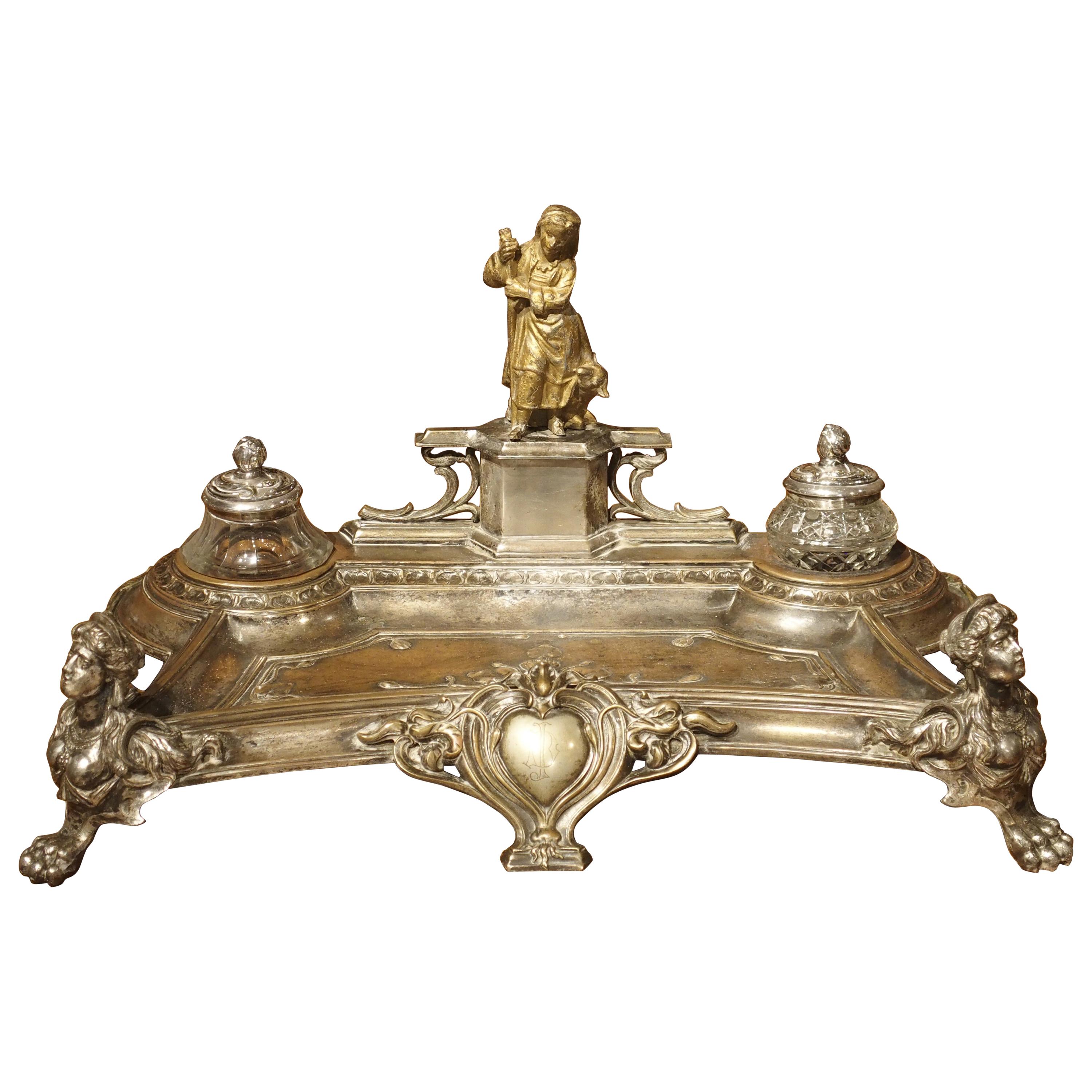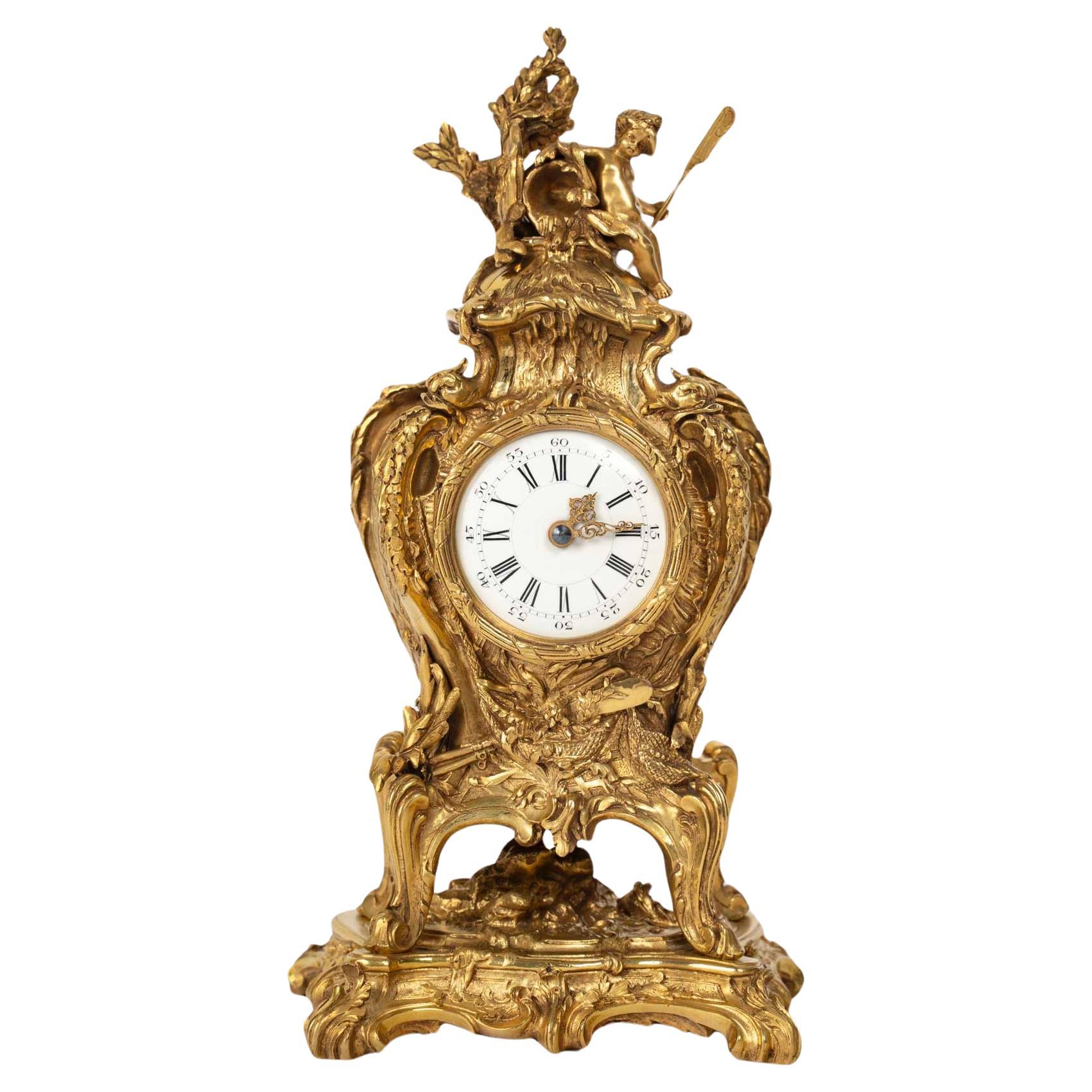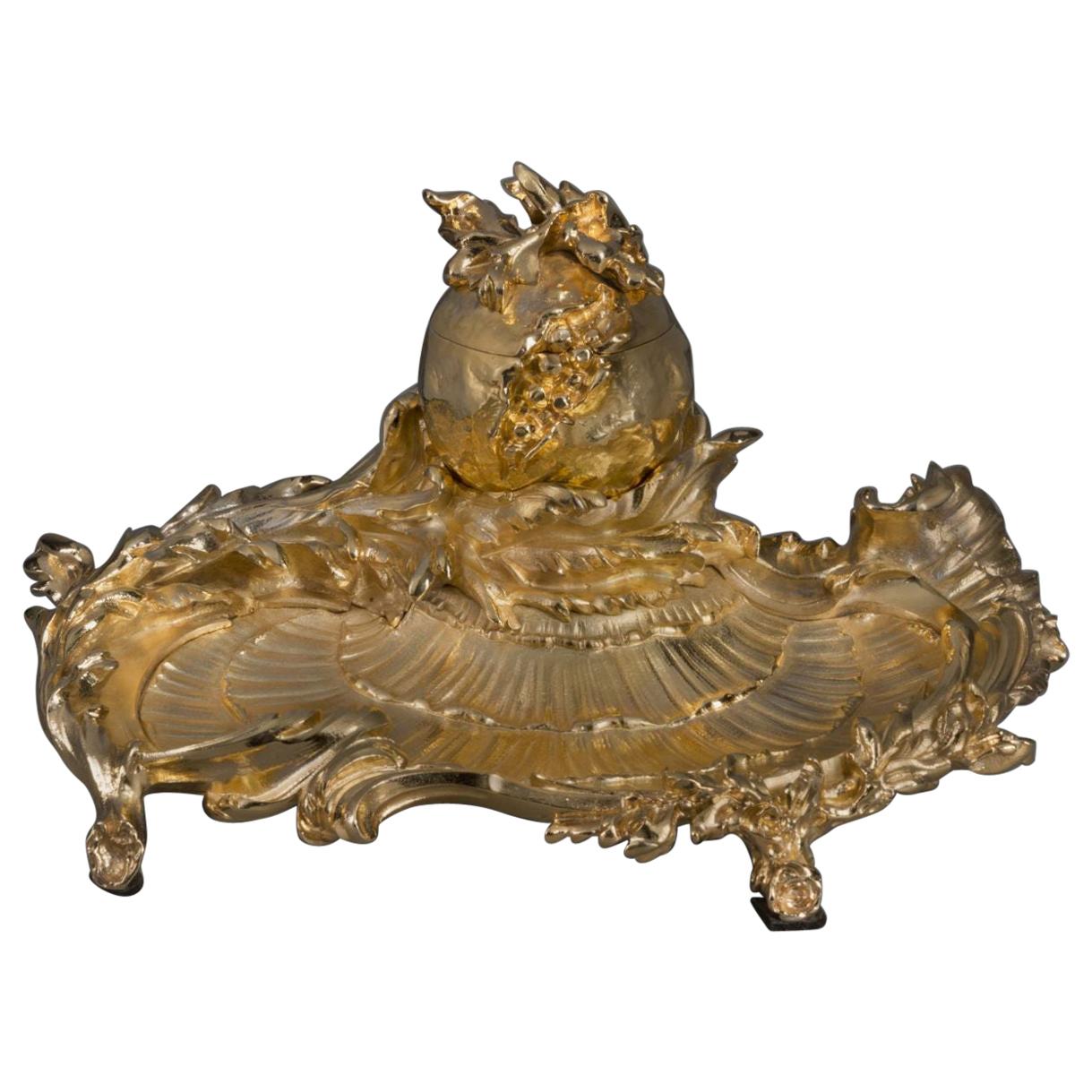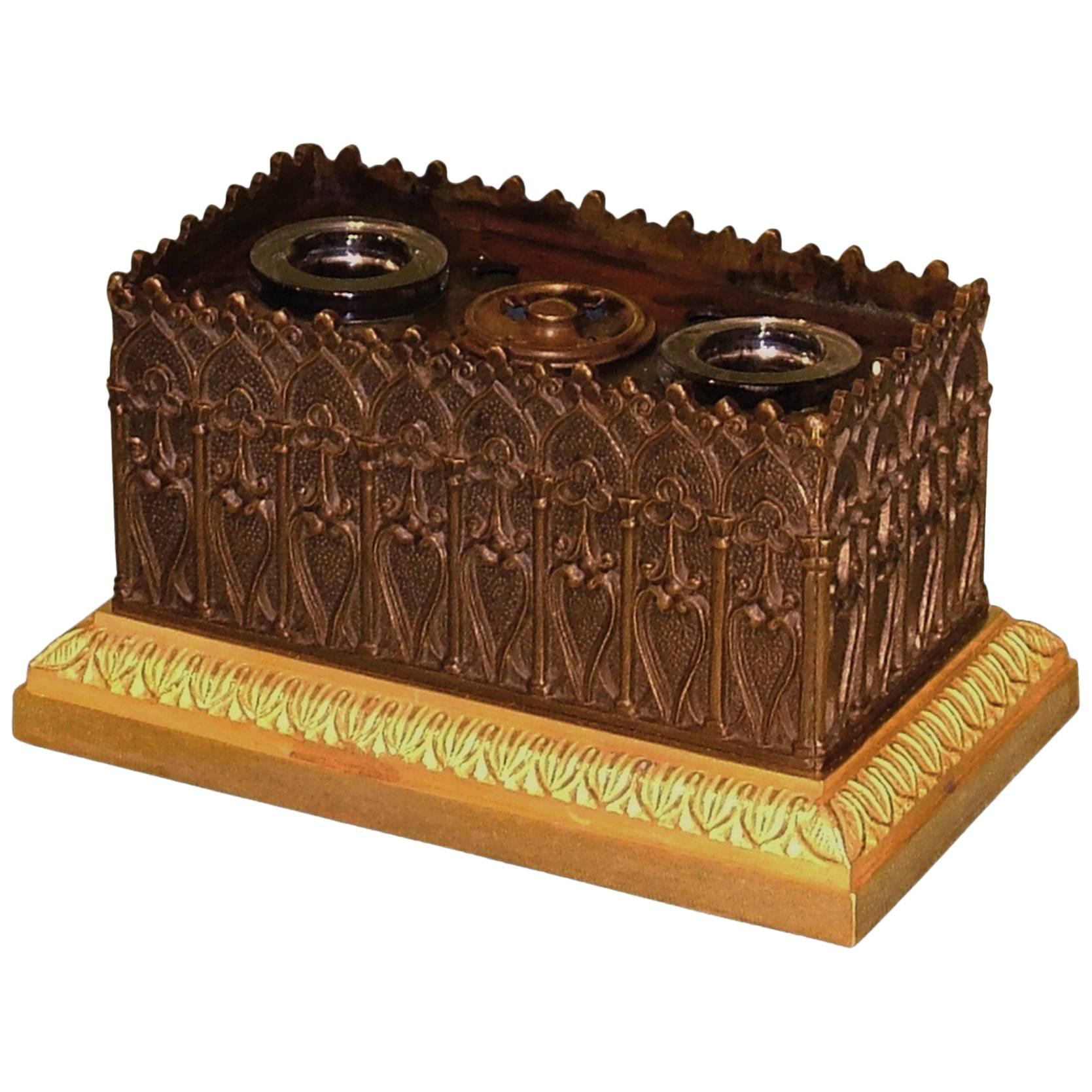Items Similar to Important Exhibition Encrier by François Linke and Léon Messagé, circa 1900
Want more images or videos?
Request additional images or videos from the seller
1 of 10
Important Exhibition Encrier by François Linke and Léon Messagé, circa 1900
About the Item
A very rare and important exhibition encrier by François Linke and Léon Messagé.
French, circa 1900.
Index number 709.
Signed to the edge 'F. Linke'.
This exceptional and ambitious encrier is modelled as two putti, each holding a standard and sitting on the water's edge, the two inkwells with hinged spirally-fluted covers with glass liners.
This important inkwell is based on Léon Messagé's celebrated sculptural group 'La Source' and was originally intended by Linke to form part of his spectacular Stand at the 1900 Paris Exposition Universelle. Like seven or eight other pieces originally intended for inclusion on the Stand, it would seem the encrier was a casualty of both Linke's over-ambitious production schedule and the financial burden that the manufacture of such ornate and high quality work imposed. It was eventually shown on the Stand in September after the gilding was finished by Picard at a cost of 90 French francs. The costs of the model were very high: some 2024 francs (of which Message's combined fee was 1158 francs 40 centimes), underlining the originality and complexity. The 1900 Exposition example was sold, along with three important pieces of furniture from the Stand (the Grand bureau and associated armchair, and the Bahut Louis XV Mars et Vénus), to the South African banker and diamond merchant Solomon Joel. A further six encriers were produced up until 1925.
Object Literature:
Payne, Christopher. François Linke, 1855-1946, The Belle Époque of French Furniture, p. 90, pl. 97; p. 149, pl. 157; p. 150; pp. 182-183, pls 197 & 198 as exhibited at the Liege exhibition in 1905 & p. 480 for the original notes in Linke's Blue daybook of the late 1890s.
François Linke (1855 - 1946) was the most important Parisian cabinet maker of the late nineteenth and early twentieth centuries, and possibly the most sought after cabinet maker of his period.
He was born in 1855 in the small village of Pankraz, in what is now the Czech Republic. Records show that Linke served an apprenticeship with the master cabinetmaker Neumann, then in 1875 at the age of 20 he arrived in Paris where he lived until he died in 1946.
It is known that the fledgling Linke workshops were active in Paris in the Faubourg St. Antoine as early as 1881, and during this time he supplied furniture for other more established makers such as Jansen and Krieger.
The quality of Linke's craftsmanship was unsurpassed by any of his contemporaries and reached its peak with his spectacular Stand at the Paris Exposition Universelle in 1900, where his Grand Bureau took the Gold Medal. He gambled his fortune and reputation on this Stand, exhibiting several breathtaking items of furniture with sculptural mounts of the most exceptional quality and proportion. His gamble worked and his reputation was established to such an extent that Linke continued to be the pre-eminent furniture house in Paris until the Second World War.
As the Art Journal reported in 1900 on Linke's Stand:
'The work of M. Linke ... was an example of what can be done by seeking inspiration amongst the Classic examples of Louis XV and XVI without in any great sense copying these great works. M. Linke's work was original in the true sense of the word, and as such commended itself to the intelligent seeker after the really artistic things of the Exhibition. Wonderful talent was employed in producing the magnificent pieces of furniture displayed....'
The formation of Linke's distinctive style was made possible by his collaboration with the sculptor Léon Messagé.
Together Linke and Messagé designed furniture for Linke's 1900 exhibition Stand, with exuberant allegorical figures cast in high relief, that exemplified Linke's ability to seamlessly merge the different mediums of wood carving, bronze and marquetry into a dynamic unified whole.
Today Linke is best known for the exceptionally high quality of his work, as well as his individualism and inventiveness. All of his work has the finest, most lavish mounts, very often applied to comparatively simple carcasses. The technical brilliance of his work and the artistic change that it represented were never to be repeated.
Bibliography:
Payne, Christopher. François Linke, (1855 - 1946), The Belle Époque of French Furniture, Antique Collectors' Club, (Woodbridge, UK), 2003.
Meyer, Jonathan. Great Exhibitions - London, New York, Paris, Philadelphia, 1851-1900, Antique Collectors' Club, (Woodbridge, UK), 2006; pp. 298 - 300.
LeDoux - Lebard, Denise. Les Ébénistes du XIXe siècle, Les Editions de l'Amateur, (Paris), 1984; pp. 439-43.
Revue Artistique & Industrielle, (Paris), July-August 1900.
Coral Thomsen, D. (ed), The Paris Exhibition 1900, The Art Journal, 1901; p.341.
Léon Messagé (1842-1901) had a brilliant, but short lived career. He is best known for his incredible sculptural collaboration with François Linke for the 1900 Paris Exposition Universelle. A gifted sculptor, Messagé was also responsible for much of the design and creative work for Roux et Brunet and Joseph-Emmanuel Zwiener.
Messagé enjoyed great success as a designer/sculptor before his collaboration with Linke. Indeed he was mentioned as a Gold Medal winner at the 1889 International Exhibition and was especially praised for his work on a cabinet by Zwiener. He came into contact with Linke in 1885 and it appears from then on Linke employed him on a regular basis.
Messagé was primarily influenced by Rococo ornament but he strove to re-interpret it. He did not produce slavish copies, and his original approach can be appreciated in Linke's celebrated Grande Bibliothèque and Grand Bureau exhibited at the 1900 Paris Exposition Universelle. A number of drawings by Messagé are recorded and after his success at the exhibition of 1889 he was encouraged to publish his designs.
'Cahier de dessins & croquis, style Louis XV: bronzes, orfèvrerie, décoration, meubles' was first published by the sculptor himself, from his Paris address of 40 rue Sedaine. There were five sections with an elaborate title page surmounted by the sculptor's cipher or talisman of a wing, a pun on his own name as the messenger to the Gods, a motif he used many times on the handles of furniture designed for Linke.
As a sculptor Messagé was trained to produce a wax maquette or model prior to working on a piece. It is especially interesting that his maquettes were of the piece of furniture in its entirety, a rare and exacting task occasionally seen for eighteenth century French Royal commissions. For Messagé it was not just a matter of producing decorative mounts; the piece was conceived as sculpture, bronze, timber and marquetry as one.
Bibliography:
Payne, Christopher. François Linke, 1855-1946, The Belle Époque of French Furniture, Antique Collectors' Club, (Woodbridge, UK), 2003; pp. 71-95.
Mestdagh, Camille & Lécoules, Pierre. L'Ameublement d'art français: 1850-1900, Les Editions de l'Amateur, (Paris), 2010; pp. 173-176.
- Creator:François Linke (Cabinetmaker),Léon Messagé (Metalworker)
- Dimensions:Height: 14.18 in (36 cm)Width: 13.78 in (35 cm)Depth: 9.06 in (23 cm)
- Style:Louis XV (In the Style Of)
- Materials and Techniques:
- Place of Origin:
- Period:
- Date of Manufacture:circa 1900
- Condition:
- Seller Location:Brighton, GB
- Reference Number:
About the Seller
5.0
Recognized Seller
These prestigious sellers are industry leaders and represent the highest echelon for item quality and design.
Established in 1964
1stDibs seller since 2014
48 sales on 1stDibs
Typical response time: 1 hour
Associations
The British Antique Dealers' AssociationLAPADA - The Association of Arts & Antiques Dealers
- ShippingRetrieving quote...Ships From: Brighton, United Kingdom
- Return PolicyA return for this item may be initiated within 7 days of delivery.
More From This SellerView All
- Louis XV Style Vitrine Table, François Linke and Léon Messagé French, circa 1900By François LinkeLocated in Brighton, West SussexA fine Louis XV Style gilt bronze mounted table Vitrine, by François Linke, the mounts designed by Léon Messagé. Index Number 131. This elegant tabl...Category
20th Century French Louis XV Center Tables
MaterialsBronze
- Louis XV Style Inkwell, Designed by Léon Messagé and Cast By BarbedienneLocated in Brighton, West SussexA Rare Louis XV Style Gilt-Bronze Inkwell. Designed by Léon Messagé and Cast By The Ferdinand Barbedienne Foundry, Paris. Designed in the exuberant Rococo style surmounted by a sea...Category
Antique 19th Century French Rococo Inkwells
MaterialsOrmolu
- Louis XV Style Vitrine by François Linke, French, circa 1900By François LinkeLocated in Brighton, West SussexA fine Louis XV style gilt bronze-mounted Vitrine with a Brèche d’Alep Marble Top By Franc¸ois Linke Signed to the reverse of the lock ‘CT LINKE/ PARIS’. Linke index number 208. Th...Category
Antique 19th Century French Louis XV Vitrines
MaterialsOrmolu, Bronze
- Louis XV Style Marquetry Commode, Possibly by François Linke, circa 1900By François LinkeLocated in Brighton, West SussexA Louis XV style gilt bronze mounted marquetry commode with marble top, possibly by François Linke. French, circa 1900. Stamped 'Mon LEGER' to the back of the commode for the retailer Émile Léger...Category
Antique Late 19th Century French Louis XV Commodes and Chests of Drawers
MaterialsBronze
- Rare Gilt-Bronze Mounted Marquetry Pedestal Desk by François Linke, circa 1900By François LinkeLocated in Brighton, West SussexA rare gilt bronze mounted marquetry pedestal desk by François Linke. French, circa 1900. Linke Index Number 711. Linke title ‘Bureau LXV à 8 pieds’. Stamped to the insi...Category
Antique Late 19th Century French Louis XV Desks and Writing Tables
MaterialsBronze
- Rare Mahogany Folio Document Cabinet by François Linke, circa 1900By François LinkeLocated in Brighton, West SussexA rare gilt-bronze mounted mahogany Folio document cabinet by François Linke, with a unique locking system by Clément Linke. French, circ...Category
Antique Late 19th Century French Cabinets
MaterialsBronze
You May Also Like
- Silvered Brass and Gilt Encrier with Shepherdess and Monogram, circa 1900Located in Dallas, TXThis charming encrier, or inkwell, is made from silvered brass and gilt bronze. A central gilded figure holding a shepherd’s crook stands on top of a hexagonal pedestal with supporti...Category
Antique Early 1900s German Art Nouveau Inkwells
MaterialsCrystal, Brass, Bronze
- Attributed to L.Messagé (1842-1901) and F.Linke, "Source Allegory" ClockBy François LinkeLocated in Saint-Ouen, FRAttributed to Leon Messagé (1842-1901) and François Linke (1855-1946) Gilt bronze clock surmounted by an allegory of the Source. With rocaille decoration, resting on four cambered l...Category
Antique 1890s French Napoleon III Table Clocks and Desk Clocks
MaterialsOrmolu, Enamel
- Regency period bronze and ormolu gothic encrierLocated in London, GBAn early 19th century Regency period bronze and ormolu encrier, having inkwells and star pierced sander, contained in Gothic fret body, supported on leaf decorated plinth base.Category
Antique Early 19th Century English Regency Inkwells
MaterialsOrmolu, Bronze
- Francois Linke Giltwood TorchèreBy François LinkeLocated in West Palm Beach, FLFrancois Linke, Louis XIV style giltwood torchère, 1907. Index number 1546 Paris, 1907. Carved giltwood. Measures: height 5 ft. 3 1/2 in.; diame...Category
Antique Early 1900s Torchères
MaterialsGiltwood
- Very Fine Linke Figural Doré Bronze Crystal Inkwell Ormolu Drawer CandelabraBy François LinkeLocated in Roslyn, NYExtremely fine cherub figural two-tone doré bronze with original crystal inkwells and ink inserts attributed to F. Linke. The two cherubs sit atop this beautiful bronze piece which i...Category
Antique 1890s French Rococo Desk Accessories
MaterialsBronze
- Rare Art Nouveau French Ormolu and Crystal Inkwell Encrier by BaccaratBy Cristalleries De BaccaratLocated in New York, NYA Rare Art Nouveau French Ormolu and crystal inkwell Encrier by Baccarat, circa 1900, the ormolu possibly by Francois Linke. Depicting a reclined winged maiden...Category
Early 20th Century French Art Nouveau Inkwells
MaterialsCrystal, Bronze, Ormolu
Recently Viewed
View AllMore Ways To Browse
The Great Exhibition Furniture
1900 Exhibition
Exhibition Stand
Antique Exhibition London
Important Sign 19th
Important Desk
Important Royal
Antique Desk Circa 1900
Exposition 1900
Leon Leon Design
Eighteenth Century French
Eighteenth Century France
1851 Exhibition
Coral Accessory
Antique Exhibition Quality
1925 Exhibition Decorative Art
Leon Wood
Exposition Paris 1900





